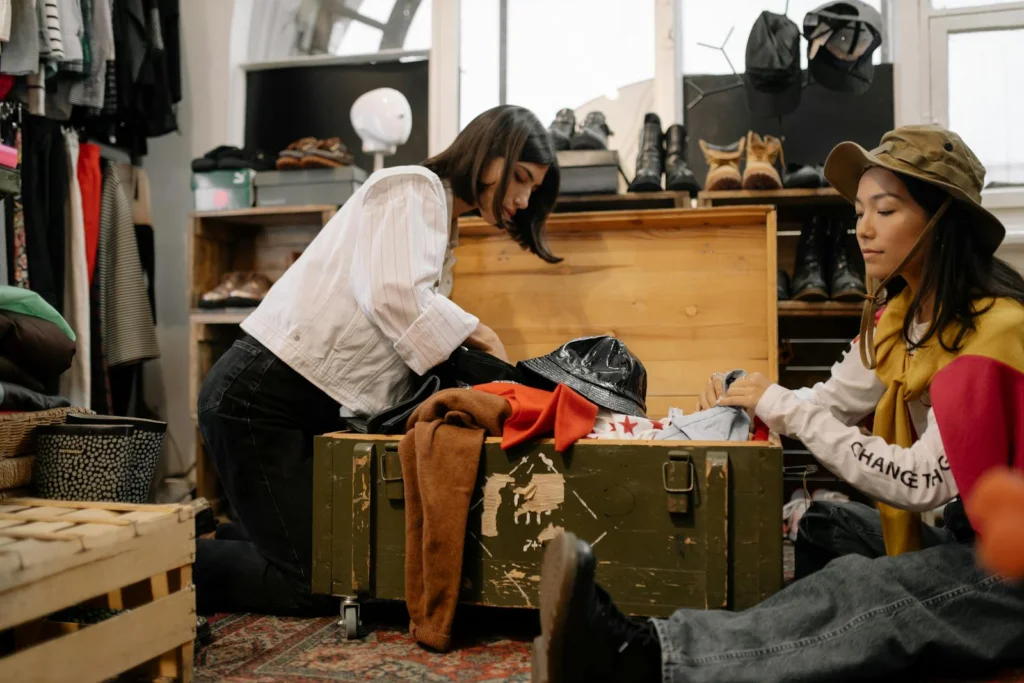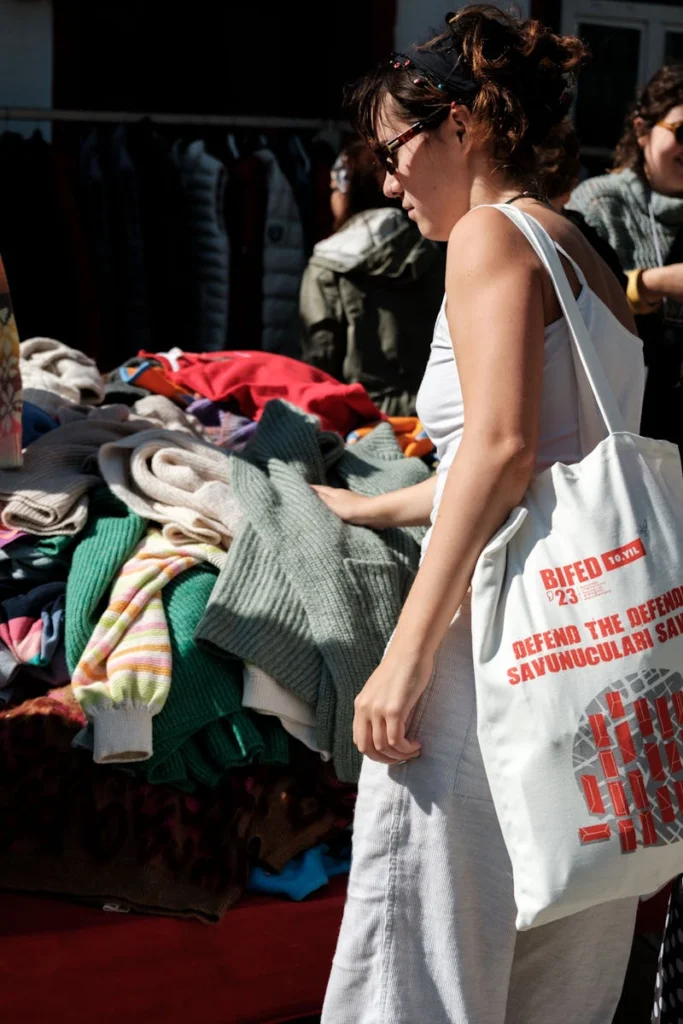
Individuals have likely traversed past remarkable designer items at thrift stores without even recognizing it. That $8 blazer could be worth $800, and that “no-name” handbag might actually be authentic luxury. The secret isn’t luck—it’s strategy. Savvy thrifters know precisely when to shop, where to look, and what details separate real treasures from clever knockoffs. Once you master these insider techniques, you’ll commence identifying designer gems that others overlook entirely.
Know the Best Days to Shop Each Store Type
Timing your thrift store visits can make the difference between finding amazing designer pieces and walking away empty-handed. You’ll dominate the best finds when you shop weekday mornings, typically between 9-11 AM. Most shoppers hit stores on weekends, leaving weekday treasures untouched for savvy hunters like you.
Different store types follow predictable patterns. Goodwill receives fresh inventory Monday through Wednesday mornings. Salvation Army typically stocks new items Tuesday and Thursday. Local charity shops often receive weekend donations, making Monday mornings prime time.
Monitor store donation schedules by building relationships with staff members. They’ll share insider knowledge about when wealthy neighborhoods drop off items. Some stores even announce big donation days on social media. You’ll gain exclusive access to premium pieces before casual browsers arrive!
Just like successful nail salons understand their target market to maximize profits, smart thrifters research donation patterns to find the best designer deals.
Research High-End Neighborhoods for Premium Finds

Location strategy works hand-in-hand with perfect timing to maximize your designer discoveries. You’ll find the best pieces where wealthy shoppers donate their closets. Scout local consignment shops in affluent zip codes first – they’re goldmines for barely-worn designer items.
Location strategy and perfect timing combine to unlock designer treasures in affluent neighborhoods where wealthy donors refresh their closets seasonally.
Research luxury thrift store locations using online maps and reviews. Target areas near high-end shopping districts, private schools, and million-dollar neighborhoods. These spots consistently receive donations from fashion-conscious donors who replace their wardrobes seasonally.
Don’t overlook hospital auxiliary shops and charity stores in upscale communities. Board members from these areas often contribute premium pieces. You’ll discover $2,000 handbags for $25 and designer blazers under $15.
Create a route hitting three to four prime locations in wealthy districts. This focused approach beats wandering random stores and delivers consistent designer finds. Focus on finding designer labels from the 1960s-1980s, as these pieces hold exceptional value and appeal to vintage collectors willing to pay premium prices.
Master the Art of Fabric Recognition
While location gets you in the door, your hands become the ultimate detective tools for spotting authentic designer pieces. You’ll develop a keen sense for fabric quality by feeling different textures regularly. Run your fingers across materials to assess their weight, smoothness, and construction.
Focus on these telltale signs of superior fabric composition:
- Heavy weight – Designer pieces feel substantial, not flimsy
- Smooth finish – Quality fabrics have even textures without pilling
- Clean seams – Professional stitching indicates premium construction
You’ll quickly distinguish between polyester blends and genuine silk, wool, or cashmere. Designer brands invest in expensive materials that age beautifully. Trust your touch when examining garments – that luxurious feel translates to lasting value and elevated style in your wardrobe.
Learn Designer Authentication Markers

Beyond fabric quality, authentic designer pieces carry specific markers that separate genuine articles from knockoffs. You’ll want to examine authentication logos carefully – they should be crisp, properly aligned, and use correct fonts. Real designer labels never have spelling errors or fuzzy printing.
Next, identify genuine material tags inside garments. Authentic pieces feature high-quality care labels with proper country-of-origin information. You’ll notice the stitching around these tags is clean and secure, not loose or fraying.
Look for serial numbers, date codes, or authenticity cards that many luxury brands include. Hardware should feel substantial and match the brand’s signature style. Zippers, buttons, and clasps won’t feel cheap or flimsy on genuine designer items. When examining jewelry pieces, check for hallmarks or stamps indicating precious metal content and quality grades. These details give you the power to spot real treasures!
Develop a Strategic Store Route Plan
Now that you can spot authentic designer pieces, you’ll maximize your finds by planning which stores to visit and when. Smart thrifters map out thrift store locations within a 20-mile radius to create efficient shopping routes. You’ll save time and gas money while hitting more stores in one trip.
Smart thrifters create strategic shopping routes within a 20-mile radius, maximizing finds while minimizing time and fuel costs.
Next, identify high traffic thrift store days to avoid crowds and discover fresh inventory. Most stores receive donations on weekdays and restock Tuesday through Thursday mornings.
Your strategic route should include:
- Upscale neighborhood stores – Higher chance of designer donations
- Chain thrift stores – Consistent pricing and frequent new arrivals
- Local charity shops – Hidden gems with lower prices
Plan your route starting with furthest locations first, then work your way back home. This systematic approach puts you ahead of casual shoppers! Consider documenting your best finds through travel photography techniques to build a portfolio that could generate additional income from your thrifting adventures.
Build Relationships With Store Staff
Getting to know thrift store employees can open incredible shopping advantages that most people never discover. You’ll gain insider access to the best pieces before they hit the sales floor. Cultivate store loyalty by visiting regularly and learning staff names. Strike up friendly conversations about new arrivals and seasonal inventory changes.
Establish frequent communication by asking about donation schedules and restock days. Many employees receive advance notice about designer pieces coming in. They’ll recollect you when luxury items arrive and might hold special pieces for 24-48 hours. Bring small treats occasionally or simply express genuine appreciation for their help.
Smart thrifters understand that staff relationships grant exclusive opportunities. You’ll discover hidden gems, learn about upcoming sales, and receive priority access to premium merchandise that transforms your wardrobe affordably. Just like finding the right Notion educator, choosing employees who offer clear explanations about inventory and store processes will make your thrifting journey more successful and enjoyable.
Understand Seasonal Inventory Cycles

Four distinct seasons create predictable donation patterns that savvy thrifters use to their advantage. You’ll discover amazing designer pieces when you analyze inventory management cycles at your favorite stores.
Spring cleaning brings formal wear and winter coats in March and April. Back-to-school season floods stores with professional clothing in August. Post-holiday purges deliver party dresses and accessories in January.
Strategic thrift shoppers capitalize on seasonal donation surges—from January’s party dress purges to August’s professional wardrobe influx.
To understand supply chain logistics, track these peak donation periods:
- January-February: Holiday gifts and formal wear from New Year’s events
- April-May: Spring cleaning wardrobe overhauls and winter item clearouts
- August-September: Professional clothing before work seasons restart
You’ll maximize your designer finds by shopping strategically during these windows. Visit stores weekly during peak seasons, but don’t ignore slower periods—competition decreases dramatically, giving you first pick of hidden gems! Just like giving your workspace a seasonal refresh with new autumn desktop wallpaper, updating your wardrobe through strategic thrifting can reinvigorate your entire style approach.
Create a Wishlist Before You Shop
Before you step foot in any thrift store, you’ll dramatically improve your success rate by creating a targeted wishlist. When you create a budget friendly thrifting wish list, you’re setting yourself up for strategic shopping victories instead of impulse purchases that drain your wallet.
Start by prioritize thrifting essentials before luxury items. Focus on wardrobe gaps like blazers, quality denim, or leather accessories that’ll maximize your styling options. Write down specific brands you’re hunting for, preferred colors, and size ranges. This focused approach prevents overwhelming decision fatigue when you’re faced with endless racks.
Your wishlist becomes your power tool, keeping you disciplined and purposeful. You’ll spend less time wandering aimlessly and more time scoring those designer pieces that’ll elevate your entire wardrobe without breaking your budget. Apply the Eisenhower Matrix to your wishlist by categorizing items based on both urgency and importance, helping you focus on the pieces that will make the biggest impact on your wardrobe first.
Perfect Your Speed Shopping Technique
Once you’ve got your wishlist ready, speed becomes your secret weapon in the competitive world of thrift shopping. You’ll dominate the game by moving fast and staying focused on your targets.
Speed and focus are your ultimate weapons for conquering the thrift store battlefield and claiming the best treasures first.
First, identify high traffic hours at your favorite stores. Most thrift shops see peak crowds on weekends and evenings. Hit them during weekday mornings when selection’s fresh and competition’s minimal. You’ll have first pick of newly stocked items.
Master these lightning-fast scanning techniques:
- Sweep the perimeter first – check end caps and featured displays
- Work systematically through sizes – don’t jump around randomly
- Trust your instincts quickly – hesitation costs you finds
Maximize window displays by checking them first. Staff often showcase the best pieces there. Move with purpose, scan efficiently, and you’ll uncover designer treasures before anyone else spots them.
Just like selecting desktop wallpapers that complement your digital space, choosing thrift pieces requires matching items to your existing style and seasonal needs.
Know Which Brands Hold Their Value
While speed gets you first dibs on great finds, recognizing valuable brands separates amateur thrifters from profit-making pros. You’ll want to memorize luxury labels that maintain strong brand reputation even secondhand. Think Chanel, Louis Vuitton, Hermès, and Rolex—these powerhouse names command premium prices decades later.
Focus on mid-tier brands with solid investment potential too. Coach handbags, Levi’s vintage denim, and Patagonia jackets consistently deliver returns. You’re building wealth while looking amazing! Research which specific styles appreciate most. For example, Birkin bags increase in value, while trendy seasonal pieces don’t.
Create a mental database of logos, fonts, and hardware details. Authentic luxury items feature precise craftsmanship you’ll recognize instantly. This knowledge transforms casual browsing into strategic hunting, putting serious money back in your pocket. When you find quality pieces at thrift prices, you’re investing in income-generating assets that can be resold for profit later.

Inspect Garments for Repair Potential
How can you turn damaged designer pieces into incredible bargains? You’ll master the art of spotting fixable flaws that scare away other shoppers. Smart thrifters know that minor imperfections often mean major savings on luxury items.
When you inspect garments for loose threads, don’t automatically dismiss pieces with simple repairs needed. A $300 blazer with a loose button becomes your $15 steal! Similarly, when you inspect garments for stains, consider whether they’re removable or concealable.
Focus on these repairable issues:
- Missing buttons or broken zippers – easily replaceable hardware
- Small tears in seams – simple stitching fixes most problems
- Minor stains on hidden areas – dry cleaning works miracles
You’re building a designer wardrobe by seeing potential where others see problems. That’s power shopping at its finest!
Time Your Visits Around Donation Drops
Since most people donate items during spring cleaning and year-end decluttering, you’ll find the best designer pieces by timing your thrift store visits strategically. Smart thrifters plan their schedule around donation drives at churches, community centers, and upscale neighborhoods. These events flood stores with quality items within days.
Call your favorite stores weekly to monitor donation schedule changes, as many receive bulk donations on specific days. Mondays often bring weekend donations, while Wednesdays typically see midweek drops from estate sales. You’ll discover that wealthy neighborhoods donate seasonally – think January purges and May spring cleaning.
Visit stores within 24-48 hours after major donation events. This timing puts you ahead of other bargain hunters, giving you first access to designer treasures before they’re picked through. Spring cleaning season brings the highest volume of donations as homeowners deep clean their spaces and purge items that accumulated over winter.
Recognize Quality Hardware and Notions
Before you even check the label, examine the buttons, zippers, and hardware to spot authentic designer pieces. These details separate high-end items from mass-market knockoffs, giving you the power to identify true treasures.
When you recognize quality zippers, you’ll notice they glide smoothly without catching or sticking. Designer brands invest in premium YKK or Lampo zippers that’ll last decades. To identify quality buttons, look for natural materials like mother-of-pearl, horn, or metal with substantial weight. Cheap plastic buttons feel flimsy and often have visible mold lines.
Focus on these telltale signs of designer craftsmanship:
- Hardware stays firmly attached – no loose threads or wobbly elements
- Metal components resist tarnishing – brass and gold-tone maintain their luster
- Engravings appear crisp and deep – not shallow or blurry imprints
Master these details, and you’ll consistently uncover designer gems others overlook!
Study Designer Silhouettes and Cuts
The way a garment drapes and fits your body reveals more about its designer origins than any logo ever could. You’ll develop an expert eye by learning to spot signature cuts that scream luxury.
Study seasonal designer collections online before hitting thrift stores. Notice how high-end brands create distinctive shoulder lines, waist placements, and hemline proportions.
Analyze fashion runway silhouette trends from major fashion weeks. You’ll start recognizing when that $8 blazer has the same structured shoulders as a $2,000 designer piece. Focus on details like lapel widths, sleeve tapering, and how seams fall naturally on your frame.
Train yourself to identify quality construction through fit alone. Designer pieces typically have better proportional balance and create flattering lines that cheap knockoffs can’t replicate. You’ve got this!
Master the Gentle Haggling Approach
Although many thrifters feel awkward about negotiating prices, you’ll find that most shop owners expect some friendly bargaining, especially on higher-priced items. Be confident when approaching negotiations – you’re not being rude, you’re participating in a time-honored shopping tradition.
Start your haggling strategy with these proven techniques:
- Bundle items together – Ask for a discount when buying multiple pieces
- Point out minor flaws – Mention small stains or missing buttons politely
- Suggest a reasonable counter-offer – Propose 10-20% less than the asking price
Use friendly tone throughout your conversation. Smile, make eye contact, and treat the interaction like you’re chatting with a neighbor. Most shop owners appreciate customers who engage respectfully. If they decline your offer, accept gracefully and move on. You’ll master this skill with practice!
Follow Estate Sale Schedules

Every weekend, estate sales offer treasure hunters their best chance to discover authentic designer pieces at bargain prices. You’ll uncover Chanel blazers for $30 and Hermès scarves for $15 when you know where to look.
Start by learning how to find estate sale schedules in your area. Check EstateSales.net and Craigslist weekly to track upcoming estate sales. Many companies also maintain email lists that’ll give you advance notice of their best events.
Focus on upscale neighborhoods where wealthy families are more likely to own designer items. Mark your calendar for sales in areas like Beacon Hill or Beverly Hills. Arrive early on Friday mornings when sales typically begin – the best pieces disappear within hours. You’ll develop a winning routine that consistently delivers designer treasures.
Check Multiple Locations of Chain Stores
While thrift stores stock different inventory at each location, smart shoppers maximize their finds by visiting multiple branches of the same chain. You’ll discover that each store reflects its neighborhood’s shopping habits and donation patterns. Wealthy areas often yield premium designer pieces, while college towns offer trendy contemporary brands.
Each thrift store location mirrors its community’s style preferences and donation habits, creating unique shopping opportunities for savvy hunters.
Create a strategic rotation to shop weekly sales across different locations. Here’s your power approach:
- Map out 3-4 nearby chain locations within a 20-mile radius
- Visit each store on different days to catch fresh inventory
- Track which locations consistently stock your preferred brands
Don’t forget to monitor clearance racks at every stop! Each store manager sets different markdown schedules, so Tuesday’s full-price item at Store A might be deeply discounted at Store B. You’ll build an impressive designer wardrobe by expanding your hunting territory.
Learn to Spot Alterations Gone Wrong
Finding that perfect designer piece can turn sour when you discover sloppy alterations at home. You’ll save yourself disappointment by learning to identify ill fitting alterations before purchasing. Check shoulder seams first – they should sit naturally at your shoulder points, not droop or pull tight.
Run your fingers along seams to feel for puckering or uneven stitching. Quality alterations lie flat and smooth. Don’t forget to spot uneven hemlines by holding garments up to eye level. Crooked hems scream amateur work and won’t give you that polished designer look you’re after.
Examine button placement and zipper alignment too. Professional alterations maintain the garment’s original proportions while poorly done work creates awkward fits that’ll frustrate you every time you wear the piece.
Understand Consignment Shop Pricing Cycles
Once you’ve mastered identifying quality pieces, timing your shopping trips can make the difference between paying full price and snagging incredible deals. Consignment shops follow predictable seasonal pricing patterns that savvy shoppers exploit. You’ll find the best deals during these strategic windows:
Master the art of strategic timing to transform from full-price shopper into deal-hunting expert at consignment stores.
- End-of-season clearances (winter coats in March, summer dresses in September)
- Mid-month inventory pushes when shops need space for new arrivals
- Holiday weekends when stores run promotional discounts
Consignment inventory turnover typically happens every 60-90 days. Shop Wednesday through Friday mornings when fresh pieces hit the floor but weekend crowds haven’t picked through everything yet. You’ll discover designer blazers marked down 40-60% during these cycles. Track your favorite shops’ patterns for three months, and you’ll expose their pricing rhythm!
Recognize Vintage Designer Era Markers
After you’ve timed your shopping trips perfectly, learning to identify authentic vintage designer pieces becomes your next superpower for scoring incredible finds. You’ll dominate thrift stores when you master vintage designer era identifiers that separate genuine treasures from knockoffs.
Study label styles from different decades – 1960s Chanel features specific font types, while 1980s Versace displays distinct logo placements. Hardware quality reveals authenticity; real designer zippers, buttons, and clasps feel substantial and move smoothly. Construction details matter too – examine stitching patterns, seam finishes, and fabric choices that luxury brands perfected.
Recognizing designer era markers means knowing signature elements like Hermès date stamps, Louis Vuitton pattern alignments, and Gucci’s evolving logo designs. You’ll spot $2,000 jackets priced at $15 once you’ve trained your eye to catch these telltale signs.
Know When to Walk Away From Damaged Items
Even when you’ve spotted that perfect designer piece, damaged items can quickly turn your bargain into an expensive mistake. You’ll develop sharp instincts for walking away from tempting but flawed finds.
The most expensive thrift find isn’t the designer label—it’s the damaged piece that looks like a steal but costs more to fix.
Learn to spot hidden flaws in fabrics by checking seams, hems, and high-wear areas like elbows and knees. Run your fingers along the material to feel for thin spots or pulls you might miss visually.
Avoid these damaged items completely:
- Silk with water stains or discoloration – these rarely come out
- Leather with cracking or deep scratches – repair costs exceed savings
- Items missing original hardware – replacement parts are expensive
Don’t fall for overpriced “collectibles” with significant damage. Recall, you’re building a wardrobe, not a museum collection. Trust your instincts and keep searching!
Develop an Eye for Timeless Pieces
While trends come and go, timeless pieces form the backbone of any smart wardrobe investment strategy. You’ll want to develop an eye for quality materials that stand the test of time. Look for natural fibers like wool, silk, and cotton – they age beautifully and maintain their shape longer than synthetic alternatives.
Learning to identify timeless silhouettes is equally pivotal for building your power wardrobe. Classic blazers, well-tailored trousers, and A-line skirts never go out of style. These pieces work seamlessly across seasons and occasions, giving you maximum versatility for your thrifting dollar.
Focus on clean lines and simple designs rather than trendy details that’ll look dated next year. A $15 vintage wool blazer can serve you for decades, while that neon statement piece might collect dust after one season!
Research Current Resale Values
Three simple steps can transform you from a casual browser into a strategic thrift shopper who spots valuable finds. You’ll master the art of recognizing pieces that hold their value despite market fluctuations.
Start by downloading apps like Vestiaire Collective and TheRealReal to check current prices. These platforms reveal what specific designer items actually sell for today. You’ll quickly identify which brands command premium prices and which have dropped in popularity.
Next, track resale trends through these essential resources:
- Rebag’s Infinity Calculator – Shows real-time handbag values
- Fashion Phile’s price guides – Tracks jewelry and accessory trends
- Fashionphile’s blog – Explains seasonal market shifts
Finally, you’ll develop instincts for spotting underpriced gems. Knowledge equals power in thrift shopping!
Master the Layaway System Strategy
When you spot an expensive designer piece that stretches beyond your budget, layaway becomes your secret weapon for securing coveted finds. You’ll gain the upper hand by making strategic moves that other shoppers overlook.
First, understand store layaway policies inside and out. Most thrift stores require 20-25% down and allow 30-90 days for full payment. Ask about fees, payment schedules, and cancellation terms upfront. This knowledge gives you negotiating power.
Next, leverage layaway to secure discounted items during peak shopping seasons. Place designer pieces on layaway before holiday rushes when prices might increase. You’ll lock in current pricing while building your dream wardrobe gradually.
Smart shoppers use layaway as their personal styling service, reserving multiple pieces until payday arrives. This strategy transforms expensive finds into manageable monthly investments.
Learn Proper Garment Storage After Purchase
You’ve secured those amazing designer finds through layaway, but your thrifting success doesn’t end at checkout. Proper storage methods will preserve your investment and keep those pieces looking runway-ready for years.
Your climate controlled environment becomes your designer wardrobe’s best friend. Store garments in a cool, dry space between 65-75°F with low humidity. This prevents fabric deterioration and color fading that can destroy your carefully curated collection.
Follow these essential storage steps:
- Clean everything first – Remove stains and odors before storing
- Use quality hangers – Invest in wooden or padded hangers for structure
- Protect with covers – Breathable garment bags shield from dust and pests
You’re building a powerful wardrobe that rivals expensive boutiques. Treat each piece with the respect it deserves, and you’ll maintain that designer aesthetic without the designer price tag!
Recognize Counterfeit Warning Signs
The fashion world’s biggest pitfall awaits unsuspecting thrift shoppers hunting for luxury brands. You’ll encounter fake designer pieces that’ll drain your wallet and damage your reputation. Master the art of spotting counterfeits before they fool you.
Look for low quality materials first. Authentic designer items use premium fabrics, genuine leather, and sturdy hardware. If that “Gucci” bag feels flimsy or has cheap plastic buckles, walk away immediately.
Next, examine for incorrect branding carefully. Check logos, fonts, and spacing against official brand images on your phone. Misspelled words, crooked stitching, or poorly aligned logos scream fake. Serial numbers and authenticity cards should match the brand’s standards perfectly.
You’ve got this! Trust your instincts and don’t rush purchases when something feels off.
Time Your Shopping Around Holiday Returns
Smart thrifters know that January through March offers the best treasure hunting opportunities at secondhand stores. You’ll discover incredible designer pieces when people donate unwanted holiday gifts and post-holiday decluttering items flood the market.
Post-holiday donations create a treasure trove for thrift shoppers seeking designer pieces at unbeatable prices.
Monitor donation schedules at your favorite thrift shops to maximize your chances of finding fresh inventory. Many stores receive their biggest donations during these months, creating perfect hunting conditions for savvy shoppers like you.
Watch for reseller discounts during this peak season too. Here’s your strategic timing approach:
- January: Target the first two weeks for holiday returns and gift donations
- February: Focus on winter clearance items and Valentine’s Day aftermath
- March: Capitalize on spring cleaning donations before Easter
You’ll consistently find higher-quality designer pieces when you align your shopping schedule with these predictable donation patterns.
Know Which Items to Buy Oversized
Certain designer pieces work beautifully when you buy them one or two sizes larger than your usual fit. You’ll transform basic thrift finds into high-end statement pieces with this strategic approach.
Blazers are your power move – oversized designer jackets instantly elevate any outfit and create that coveted boardroom authority. Vintage band tees from premium brands look effortlessly cool when they’re roomy. Designer sweaters and cardigans drape elegantly when oversized, giving you that expensive casual vibe.
However, know which oversized items flatter your frame before purchasing. Skip oversized pants unless you’re planning alterations – they’ll overwhelm your silhouette. Also, recognize oversized pieces that can be tailored effectively. Structured items like blazers and coats work perfectly, but avoid buying oversized shoes or accessories. They’ll never fit properly, wasting your investment in designer style.
Perfect Your Dressing Room Evaluation Process
When you’ve spotted a promising piece, your evaluation skills in the dressing room determine whether you’ll score a designer win or waste your money. You’re now in control mode, ready to make smart decisions that’ll transform your wardrobe.
Your dressing room evaluation skills are the difference between a wardrobe transformation and a costly mistake.
Start by examining mirror lighting conditions – harsh fluorescents can make colors look completely different than natural light. Move around and check how the fabric looks from multiple angles.
Master these identifying fitting room cues for quality pieces:
- Fabric drapes smoothly without pulling or bunching awkwardly
- Seams lie flat against your body without puckering
- Colors complement your skin tone even under store lighting
Take photos if allowed – they’ll reveal fit issues you might miss in person. Don’t rush this process! Spending five extra minutes scrutinizing saves you from buyer’s remorse later.
Build a Reliable Tailor Relationship
A skilled tailor becomes your secret weapon for turning thrift store finds into custom-looking pieces that rival expensive boutique items. You’ll transform ill-fitting blazers into sharp, professional attire and oversized dresses into perfectly contoured silhouettes.
Start by researching local tailors through online reviews and recommendations. Visit their shops to assess their work quality and discuss your vision clearly. A good tailor will offer honest feedback about what’s possible within your budget.
Always maintain open communication about your expectations and timeline. Don’t hesitate to discuss payment options upfront—many tailors offer flexible arrangements for regular customers. Basic alterations typically cost $15-50, far less than designer originals.
Building this relationship takes time, but you’ll gain access to professional expertise that elevates every thrifted purchase into a designer-quality investment piece.
Conclusion
You’re now equipped with insider knowledge that’ll transform your thrifting game completely. Start implementing these strategies during your next shopping trip, and you’ll discover designer pieces hiding in plain sight. Recall, successful thrifting takes practice and patience, but the payoff is incredible. You’ll build a stunning wardrobe for pennies on the dollar while developing skills that last a lifetime. Happy hunting!





Leave a Reply